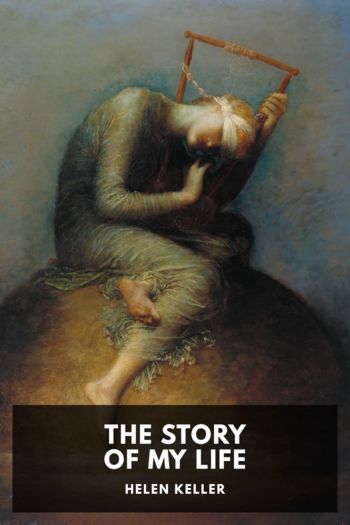The Story of My Life by Helen Keller (books to read for self improvement .TXT) 📕

- Author: Helen Keller
Book online «The Story of My Life by Helen Keller (books to read for self improvement .TXT) 📕». Author Helen Keller
She is an optimist and an idealist.
“I hope,” she writes in a letter, “that L⸺ isn’t too practical, for if she is, I’m afraid she’ll miss a great deal of pleasure.”
In the diary that she kept at the Wright-Humason School in New York she wrote on October 18, 1894, “I find that I have four things to learn in my school life here, and indeed, in life—to think clearly without hurry or confusion, to love everybody sincerely, to act in everything with the highest motives, and to trust in dear God unhesitatingly.”
III EducationIt is now sixty-five years since Dr. Samuel Gridley Howe knew that he had made his way through Laura Bridgman’s fingers to her intelligence. The names of Laura Bridgman and Helen Keller will always be linked together, and it is necessary to understand what Dr. Howe did for his pupil before one comes to an account of Miss Sullivan’s work. For Dr. Howe is the great pioneer on whose work that of Miss Sullivan and other teachers of the deaf-blind immediately depends.
Dr. Samuel Gridley Howe was born in Boston, November 10, 1801, and died in Boston, January 9, 1876. He was a great philanthropist, interested especially in the education of all defectives, the feebleminded, the blind, and the deaf. Far in advance of his time he advocated many public measures for the relief of the poor and the diseased, for which he was laughed at then, but which have since been put into practice. As head of the Perkins Institution for the Blind in Boston, he heard of Laura Bridgman and had her brought to the Institution on October 4, 1837.
Laura Bridgman was born at Hanover, New Hampshire, December 21, 1829; so she was almost eight years old when Dr. Howe began his experiments with her. At the age of twenty-six months scarlet fever left her without sight or hearing. She also lost her sense of smell and taste. Dr. Howe was an experimental scientist and had in him the spirit of New England transcendentalism with its large faith and large charities. Science and faith together led him to try to make his way into the soul which he believed was born in Laura Bridgman as in every other human being. His plan was to teach Laura by means of raised types. He pasted raised labels on objects and made her fit the labels to the objects and the objects to the labels. When she had learned in this way to associate raised words with things, in much the same manner, he says, as a dog learns tricks, he began to resolve the words into their letter elements and to teach her to put together “k-e-y,” “c-a-p.” His success convinced him that language can be conveyed through type to the mind of the blind-deaf child, who, before education, is in the state of the baby who has not learned to prattle; indeed, is in a much worse state, for the brain has grown in years without natural nourishment.
After Laura’s education had progressed for two months with the use only of raised letters, Dr. Howe sent one of his teachers to learn the manual alphabet from a deaf-mute. She taught it to Laura, and from that time on the manual alphabet was the means of communicating with her.
After the first year or two Dr. Howe did not teach Laura Bridgman himself, but gave her over to other teachers, who under his direction carried on the work of teaching her language.
Too much cannot be said in praise of Dr. Howe’s work. As an investigator he kept always the scientist’s attitude. He never forgot to keep his records of Laura Bridgman in the fashion of one who works in a laboratory. The result is, his records of her are systematic and careful. From a scientific standpoint it is unfortunate that it was impossible to keep such a complete record of Helen Keller’s development. This in itself is a great comment on the difference between Laura Bridgman and Helen Keller. Laura always remained an object of curious study. Helen Keller became so rapidly a distinctive personality that she kept her teacher in a breathless race to meet the needs of her pupil, with no time or strength to make a scientific study.
In some ways this is unfortunate. Miss Sullivan knew at the beginning that Helen Keller would be more interesting and successful than Laura Bridgman, and she expresses in one of her letters the need of keeping notes. But neither temperament nor training allowed her to make her pupil the object of any experiment or observation which did not help in the child’s development. As soon as a thing was done, a definite goal passed, the teacher did not always look back and describe the way she had come. The explanation of the fact was unimportant compared to the fact itself and the need of hurrying on. There are two other reasons why Miss Sullivan’s records are incomplete. It has always been a severe tax on her eyes to write, and she was early discouraged from publishing data by the inaccurate use made of what she at first supplied.
When she first wrote from Tuscumbia to Mr. Michael Anagnos, Dr. Howes son-in-law and his successor as Director of the Perkins Institution, about her work with her pupil, the Boston papers began at once to publish exaggerated accounts of Helen Keller. Miss Sullivan protested. In a letter dated April 10, 1887, only five weeks after she went to Helen Keller, she wrote to a friend:
“⸻ sent me a Boston





Comments (0)